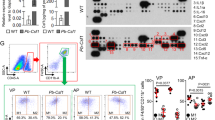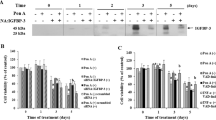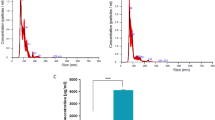Abstract
The receptor for macrophage colony-stimulating factor 1 receptor (CSF1R) is a product of the proto-oncogene c-fms and a member of the class III transmembrane tyrosine kinase receptor family. Earlier, we described increased mRNA expression of CSF1R in human telomerase reverse transcriptase (hTERT) immortalized human ovarian surface epithelial (IOSE) cell lines derived from a single donor. Here, we further describe that CSF1R is upregulated at both the mRNA and protein level in hTERT immortalized human normal OSE cells from two different donors and in hTERT immortalized human pancreatic ductal epithelial cells. CSF1R was not upregulated in hTERT immortalized epithelial clones that subsequently underwent senescence or in immortalized fibroblasts. Upon stimulation by the CSF1R ligand CSF1, the immortalized epithelial cell lines showed rapid internalization of CSF1R with concomitant down-modulation and colocalization of phosphorylated NFκBp65 with hTERT protein, hTERT translocation into the nucleus and the binding of c-Myc to the hTERT promoter region. Reducing the expression of CSF1R using short hairpin interfering RNA abolished these effects and also decreased cell survival and the number of population doublings under suboptimal culture conditions. The telomerase inhibitor GRN163L confirmed a role for telomerase in the cleavage of the intracellular domain of CSF1R. On the basis of these findings, we suggest that CSF1R may be a critical factor facilitating hTERT immortalization of epithelial cells.
This is a preview of subscription content, access via your institution
Access options
Subscribe to this journal
Receive 50 print issues and online access
$259.00 per year
only $5.18 per issue
Buy this article
- Purchase on Springer Link
- Instant access to full article PDF
Prices may be subject to local taxes which are calculated during checkout




Similar content being viewed by others
Abbreviations
- CSF1:
-
colony-stimulating factor 1
- CSF1R:
-
colony-stimulating factor 1 receptor
- IOSE:
-
immortal ovarian surface epithelial cell
- OSE:
-
ovarian surface epithelium
- PI:
-
propidium iodide
References
Akiyama M, Hideshima T, Hayashi T, Tai YT, Mitsiades CS, Mitsiades N et al. (2003). Nuclear factor-kappaB p65 mediates tumor necrosis factor alpha-induced nuclear translocation of telomerase reverse transcriptase protein. Cancer Res 63: 18–21.
Hahn WC . (2002). Immortalization and transformation of human cells. Mol Cells 13: 351–361.
Herbert BS, Gellert GC, Hochreiter A, Pongracz K, Wright WE, Zielinska D et al. (2005). Lipid modification of GRN163, an N3′ → P5′ thio-phosphoramidate oligonucleotide, enhances the potency of telomerase inhibition. Oncogene 24: 5262–5268.
Jiang XR, Jimenez G, Chang E, Frolkis M, Kusler B, Sage M et al. (1999). Telomerase expression in human somatic cells does not induce changes associated with a transformed phenotype. Nat Genet 21: 111–114.
Kacinski BM, Carter D, Mittal K, Kohorn EI, Bloodgood RS, Donahue J et al. (1988). High level expression of fms proto-oncogene mRNA is observed in clinically aggressive human endometrial adenocarcinomas. Int J Radiat Oncol Biol Phys 15: 823–829.
Kacinski BM, Chambers SK, Stanley ER, Carter D, Tseng P, Scata KA et al. (1990). The cytokine CSF-1 (M-CSF) expressed by endometrial carcinomas in vivo and in vitro, may also be a circulating tumor marker of neoplastic disease activity in endometrial carcinoma patients. Int J Radiat Oncol Biol Phys 19: 619–626.
Kacinski BM, Stanley ER, Carter D, Chambers JT, Chambers SK, Kohorn EI et al. (1989). Circulating levels of CSF-1 (M-CSF) a lymphohematopoietic cytokine may be a useful marker of disease status in patients with malignant ovarian neoplasms. Int J Radiat Oncol Biol Phys 17: 159–164.
Li NF, Broad S, Lu YJ, Yang JS, Watson R, Hagemann T et al. (2007). Human ovarian surface epithelial cells immortalized with hTERT maintain functional pRb and p53 expression. Cell Prolif 40: 780–794.
Li NF, Wilbanks G, Balkwill F, Jacobs IJ, Dafou D, Gayther SA . (2004). A modified medium that significantly improves the growth of human normal ovarian surface epithelial (OSE) cells in vitro. Lab Invest 84: 923–931.
Morales CP, Holt SE, Ouellette M, Kaur KJ, Yan Y, Wilson KS et al. (1999). Absence of cancer-associated changes in human fibroblasts immortalized with telomerase. Nat Genet 21: 115–118.
Rohrschneider LR, Bourette RP, Lioubin MN, Algate PA, Myles GM, Carlberg K . (1997). Growth and differentiation signals regulated by the M-CSF receptor. Mol Reprod Dev 46: 96–103.
Scholl SM, Pallud C, Beuvon F, Hacene K, Stanley ER, Rohrschneider L et al. (1994). Anti-colony-stimulating factor-1 antibody staining in primary breast adenocarcinomas correlates with marked inflammatory cell infiltrates and prognosis. J Natl Cancer Inst 86: 120–126.
Sherr CJ, Roussel MF, Rettenmier CW . (1988). Colony-stimulating factor-1 receptor (c-fms). J Cell Biochem 38: 179–187.
Stanley ER, Guilbert LJ, Tushinski RJ, Bartelmez SH . (1983). CSF-1—a mononuclear phagocyte lineage-specific hemopoietic growth factor. J Cell Biochem 21: 151–159.
Tang R, Beuvon F, Ojeda M, Mosseri V, Pouillart P, Scholl S . (1992). M-CSF (monocyte colony stimulating factor) and M-CSF receptor expression by breast tumour cells: M-CSF mediated recruitment of tumour infiltrating monocytes? J Cell Biochem 50: 350–356.
Urban S, Freeman M . (2002). Intramembrane proteolysis controls diverse signalling pathways throughout evolution. Curr Opin Genet Dev 12: 512–518.
Whitaker NJ, Bryan TM, Bonnefin P, Chang AC, Musgrove EA, Braithwaite AW et al. (1995). Involvement of RB-1, p53, p16INK4 and telomerase in immortalisation of human cells. Oncogene 11: 971–976.
Yang G, Rosen DG, Colacino JA, Mercado-Uribe I, Liu J . (2006). Disruption of the retinoblastoma pathway by small interfering RNA and ectopic expression of the catalytic subunit of telomerase lead to immortalization of human ovarian surface epithelial cells. Oncogene 26: 1492–1498.
Acknowledgements
We thank Professor George D Wilbanks for his great support during the collection of primary NOSE cells and Dr Simon Broad for supplying hTERT retroviral packaging cell lines. We also thank Professor Jeffrey Pollard for critically reading the manuscript and for his useful suggestions, Dr Calvin Harley and Geron Corporation for supplying the telomerase inhibitor GRN163L.
Author information
Authors and Affiliations
Corresponding author
Additional information
Supplementary Information accompanies the paper on the Oncogene website (http://www.nature.com/onc)
Supplementary information
Rights and permissions
About this article
Cite this article
Li, N., Kocher, H., Salako, M. et al. A novel function of colony-stimulating factor 1 receptor in hTERT immortalization of human epithelial cells. Oncogene 28, 773–780 (2009). https://doi.org/10.1038/onc.2008.412
Received:
Revised:
Accepted:
Published:
Issue Date:
DOI: https://doi.org/10.1038/onc.2008.412
Keywords
This article is cited by
-
PAK4 interacts with p85 alpha: implications for pancreatic cancer cell migration
Scientific Reports (2017)
-
Possible mechanisms and function of nuclear trafficking of the colony-stimulating factor-1 receptor
Cellular and Molecular Life Sciences (2014)



